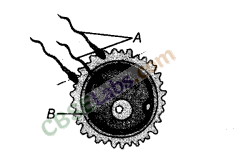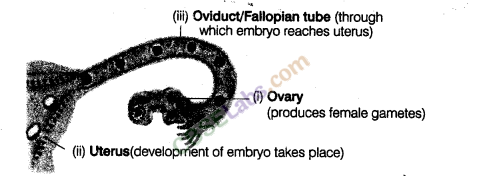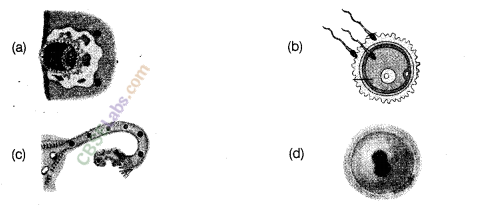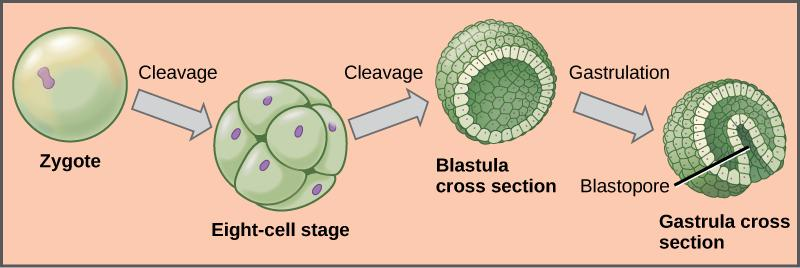NCERT Exemplar Class 8 Science Chapter 9 Reproduction in Animals are part of NCERT Exemplar Class 8 Science. Here we have given NCERT Exemplar Class 8 Science Chapter 9 Reproduction in Animals.
NCERT Exemplar Class 8 Science Chapter 9 Reproduction in Animals
Multiple Choice Questions
Question. 1 Sets of reproductive terms are given below. Choose the set that has an incorrect combination.
(a) Sperm, testis, sperm duct, penis
(b) Menstruation, egg, oviduct, uterus
(c) Sperm, oviduct, egg, uterus
(d) Ovulation, egg, oviduct, uterus
Answer. (c) Set (c) has an incorrect combination. This is because it has parts of both male and female reproductive system.
Sperm is the male gamete while oviduct, egg and uterus are parts of female reproductive system.
Question. 2 In humans, the development of fertilised egg takes place in the
(a) ovary (b) testis (c) oviduct (d) uterus
Answer. (d) The development of fertilised egg takes place in the uterus (womb). The embryo gets embedded in the wall of the uterus for development by implantation.
Question. 3 In the list of animals given below, hen is the odd one out.Human being, cow, dog, hen.
The reason for this is
(a) it undergoes internal fertilisation (b) it is oviparous
(c) it is viviparous (d) it undergoes external fertilisation
Answer. (b) Hen is odd one out because it is oviparous, i.e. it lays egg from which young ones are hatched later on.
The rest three (human being, cow and dog) are viviparous, i.e. give birth to young ones after they are fully developed.
Question. 4 Animals exhibiting external fertilisation produce a large number of gametes. Pick the appropriate reason from the following.
(a) The animals are small in size and want to produce more offsprings
(b) Food is available in plenty in water
(c) To ensure better chance of fertilisation
(d) Water promotes production of large number of gametes
Answer. (c) A large number of gametes are released by such animals to ensure better chance of fertilisation. Since, the gametes are laid in water, many of them are carried away by moving water, wind or rain and many are eaten by other animals.Therefore, production of large number of gametes is necessary.
Question. 5 Reproduction by budding takes place in
(a) Hydra (b) Paramecium (c) Amoeba (d) Bacteria
Answer. (aj In Hydra, reproduction takes place by budding. A small part of the body of an organism grows as ‘bud’ which then detaches and becomes a new organism.
The other options Amoeba, Paramecium and bacteria reproduce asexually by binary fission.
Question. 6 Which of the following statements about reproduction in humans is correct?
(a) Fertilisation takes place externally
(b) Fertilisation takes place in the testes
(c) During fertilisation, egg moves towards the sperm
(d) Fertilisation takes place in the human female
Answer. (d) Fertilisation in humans takes place in the female body. The sperms of man are introduced by penis into female’s body through vagina.
The sperms then pass through the uterus and reach to oviducts. It is here, that sperm combines with egg to form zygote (i.e fertilisation occurs).
Question. 7 In human beings, after fertilisation, the structure which gets embedded in the wall of uterus is
(a) ovum (b) embryo (c) foetus (d) zygote
Answer. (b) After fertilisation, the zygote divides repeatedly to form a ball of hundreds of cells called an embryo. The embryo moves down from oviduct into the uterus, where it gets embedded. This is called implantation.
Question. 8 Aquatic animals in which fertilisation occurs in water are said to be
(a) viviparous without fertilisation (b) oviparous with external fertilisation
(c) viviparous with internal fertilisation
(d) oviparous with internal fertilisation
Answer. (b) The aquatic animals in which fertilisation occurs in water are oviparous with external fertilisation. They lay eggs and release sperms outside body in the water for fertilisation to take place. The young one top is formed outside the body in water from the zygote formed inside eggs.
Question. 9 After fertilisation, the resulting cell which gives rise to a new individual is the
(a) embryo (b) ovum (c) foetus (d) zygote
Answer. (d) After fertilisation (i.e. combining of sperm with the egg), zygote is formed. It is the beginning of formation of a new individual. All the multicellular animals start their life from a single cell called zygote.
Question. 10 In human beings, the correct sequence of events during reproduction is
(a) gamete formation, fertilisation, zygote, embryo
(b) embryo, zygote, fertilisation, gamete formation
(c) fertilisation, gamete formation, embryo, zygote
(d) gamete formation, fertilisation, embryo, zygote
Answer. (a) In human beings, sexual reproduction takes place by the combination of gametes, i.e. sperm and egg, formed in male and female, respectively. The fusion of gametes is called fertilisation.
The fusion forms a zygote, which divides repeatedly to form the embryo. The embryo gets implanted in female uterus for further development to form foetus.
Very Short Answer Type Questions
Question. 11 Although two cells called gametes fuse, the product formed is a single cell called zygote. Justify.
Answer. During fertilisation, only the nuclei of male and female gametes fuse. The sperm reaches to egg and only its nucleus enters the egg cell and fuses with the egg nucleus to form the single-celled structure called zygote. The cell formed consists of only one nucleus but is diploid in nature.
Question. 12 Stages in the life cycle of silkworm are given below. Write them in sequential order.
Pupa, Egg, Silk moth, Caterpillar
Answer. The stages in the life cycle of silkworm occurs in following sequence:

This process of transformation from an immature form of an animal to its adult form in two or more distinct stages is called metamorphosis.
Question. 13 What is the importance of reproduction?
Answer. Reproduction is important for organisms because it ensures the continuity of life on earth. It is the means of multiplication and perpetuation of a species. It also creates variations among the population.
Question. 14 In markets, eggs of birds are available but never eggs of dogs, why?
Answer. Birds are oviparous, i.e. lay eggs outside their body. So, it is easy to collect their eggs and these are thus available in market.
On the contrary, dogs are viviparous, i.e. do not lay eggs but give birth to young ones. Their eggs are extremely small which remain inside their bodies.
Question. 15 The eggs of frogs do not have shells for protection, yet they are safe in water, how?
Answer. Frog’s eggs are without any external covering or shell but a layer of jelly hold the eggs together, thus providing them protection.
This jelly or gelatinous covering also protects them from drying up and prevents them from being eaten up by other animals or predators.
Short Answer Type Questions
Question. 16 Fill up the blanks with the terms given below:
body, asexual, binary, single, nucleus
Amoeba is a………….. celled organism. It reproduces by…………… reproduction.
The process of reproduction begins by the division of its………….. into two.
This is followed by the division of its …………… into two. This type of reproduction is called…………… fission.
Answer. Single,asexual, nucleus, body, binary
Question. 17 The term ‘metamorphosis’ is not used while describing human development. Why?
Answer. The term ‘metamorphosis’ is not used while describing human development because in human beings, body parts of an adult are present from the time of birth itself, i.e. while beginning of life as a baby and until you are an adult, the basic plan of body does not change.
On the contrary, in metamorphosis, the parts of the adult are different from those at the time of birth.
Question. 18 Mother gives birth to a baby but the baby has characters of both parents. How is this possible?
Answer. Although, mother gives birth to a baby but the baby is formed from the fertilisation of male and female gamete that comes from the father and mother, respectively. The nuclei of both the parent gametes fuse to form a zygote with new character combinations from both parents.
Hence, the zygote formed from fertilisation have characters of both the parents. This zygote develops inside the female body (uterus) and finally takes birth as baby.
Question. 19 How is reproduction in Hydra different from that in Amoeba?
Answer. Both Hydra and Amoeba reproduce asexually involving only single parent but the mode of reproduction is different.
Hydra reproduces from bulges or buds arising from the parent body that grows’ and matures into another organism, i.e. by budding, while Amoeba reproduces by binary fission, i.e. splitting of parent organism to form two new organisms.
Question. 20 State whether the following statements are True/False
1. External fertilisation can occur both in water and on land.
2. The eggs of fish are covered by hard shells for protection.
3. Human egg has a head, middle piece and tail.
4. In adult human females, a single mature egg is released into an oviduct every month.
Answer.1. False, external fertilisation occurs only in water and not on land.
2. False, the eggs of fish are covered by gelatinous or jelly-like covering for protection.
3. False, human sperm has a head, middle piece and tail.
4. True
Question. 21 Why do only malejjametes have a tail?
Answer. Male gametes or sperms have tail to facilitate movement of sperms and help them to reach the egg (female gamete) for fertilisation.
Question. 22 What does figure represent?

Answer. The .figure represents binary fission with a dividing nucleus parent in Amoeba. The single-celled parent Amoeba divides to form two daughter cells that develop into two independent Amoebae.
Question. 23 Observe the given figure and answer the questions that follow.

(a) Label A and B.
(b) Identify the process.
(c) What happens during the process and what is formed?
Answer. (a) A-sperm, B-ovum (egg).
(b) The process is fertilisation.
(c) During the process, the sperm nucleus fuses with the egg nucleus as a result of which a zygote is formed.
Long Answer Type Questions
Question. 24 How can we say that fish exhibits external fertilisation?
Answer. Female fish lay eggs in water while male fish releases its sperms in water. Sperms swim and reach the eggs of fish, randomly due to water currents.When a sperm comes in contact with the viable egg, nuclei of both the cell fuses to form a zygote. This process of fertilisation takes place in water outside the female body, hence fertilisation is external in fishes.
Question. 25

After Observing above figure, answer the following,
(a) Read the following statements and label them in the figure.
1.The part which produces female gametes.
2. The part where development of the baby takes place.
3. The part through which the developing embryo passes to reach the uterus.
(b)Explain the future development of the embryo that would take place
after it gets embedded in the uterus.
Answer. (a) The parts in the figure are labelled below:

(b) The embryo continues to grow and develop after it gets embedded in the uterus. It divides and differentiates into three germ layers which give rise to different body : parts such as hands, legs, head, eyes, ears, etc. This stage where all the body parts are distinct and easily identified in developing embryo is called foetus.
A human embryo becomes a foetus after about 8 weeks of pregnancy. After completion of development of foetus (i.e. after about 38 weeks or 9 months), mother gives birth to baby.
Question. 26 Hens and frogs are both oviparous exhibiting different types of fertilisation, explain.
Answer. Hens are oviparous in which internal fertilisation takes place. The fertilised egg divides repeatedly to form an embryo inside the body. The embryo however, travels down the oviduct with many protective layers forming around it. After the hard egg shell is formed around the developing embryo, the hen lays the eggs outside. After about 3 weeks, the development of chick from egg takes place.
On the contrary, frogs are oviparous in which external fertilisation occurs. The frogs lay eggs and sperms in water, which comes in contact to undergo fertilisation. In this way, a female frog’s eggs get fertilised by sperms outside its body, i.e external fertilisation.
The fertilised eggs are covered by a jelly for protection. The development of embryo takes place in the egg in water, i.e they are oviparous.
Question. 27 Observe the following figures.

(i) Identify the stages (a) to (d) in figure during development of human baby.
(ii) Arrange the stages in correct sequence of development.
(iii) Explain the development that takes place in any one stage.
Answer. 1. The figures showing stages during development of embryo are identified as
(a) Embedding of the embryo in the uterus (implantation).
(b) Fertilisation (fusion of egg and sperm).
(c) Stages in development of an embryo from the zygote in the oviduct, till it gets embedded in uterus.
(d) Zygote (showing fusion of nuclei)
2. The above stages in sequence are:

3. Development of embryo The embryo after being implanted in uterus, continues to develop and divide and differentiate into body parts. The stage of embryo when body parts become distinct and identified is called foetus. After complete development of foetus, mother gives birth to baby.
NCERT Exemplar Class 8 Science Solutions
- Chapter 1 Crop Production and Management
- Chapter 2 Microorganisms: Friend and Foe
- Chapter 3 Synthetic Fibres and Plastics
- Chapter 4 Materials : Metals and Non-Metals
- Chapter 5 Coal and Petroleum
- Chapter 6 Combustion and Flame
- Chapter 7 Conservation of Plants and Animals
- Chapter 8 Cell Structure and Functions
- Chapter 9 Reproduction in Animals
- Chapter 10 Reaching the Age of Adolescence
- Chapter 11 Force and Pressure
- Chapter 12 Friction
- Chapter 13 Sound
- Chapter 14 Chemical Effects of Electric Current
- Chapter 15 Some Natural Phenomena
- Chapter 16 Light
- Chapter 17 Stars and the Solar System
- Chapter 18 Pollution of Air and Water
NCERT Exemplar SolutionsNCERT Exemplar MathsNCERT Exemplar Science
We hope the NCERT Exemplar Class 8 Science Chapter 9 Reproduction in Animals help you. If you have any query regarding NCERT Exemplar Class 8 Science Chapter 9 Reproduction in Animals, drop a comment below and we will get back to you at the earliest.